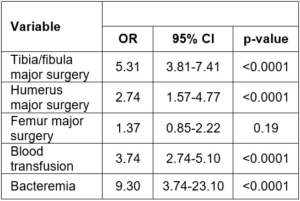No Increased Risk of Osteomyelitis Associated with Long Bone Shaft Fractures
uthor(s):
Areg Grigorian; Sebastian Schubl; John Scolaro; Viktor Gabriel; Allison Hu; Gino Petrosian; Victor Joe; Jeffry Nahmias
Background:
Osteomyelitis of the long bones can result from hematogenous spread, direct inoculation or from a contiguous focus of infection. Osteomyelitis after long bone fractures ranges between 4-64 % in previous studies. Risk of osteomyelitis after long bone fractures has not been studied using a large national database.
Hypothesis:
We hypothesized that long bone shaft fracture and major bone surgery are independent risk factors for osteomyelitis.
Methods:
This was a retrospective analysis using the National Trauma Data Bank. We included all patients > 18 years of age and grouped them by presence of long bone (femur, tibia/fibula, humerus) shaft fractures and major bone surgery. We included previously reported risk factors for osteomyelitis into a univariate linear regression model. Covariables used in our multivariate analysis included history of diabetes, end-stage renal disease, peripheral arterial disease, smoker, steroid use, major bone surgery, blood transfusion, bacteremia, injury severity score > 25, positive blood alcohol concentration and illegal drug screen on admission.
Results:
From 5,494,609 patients, 375,290 were identified to have long bone shaft fractures (6.8%) with the majority being tibia/fibula (42.3%). The osteomyelitis rate in long bone shaft fractures was 0.5% but the overall rate was 0.02%. A demographic analysis of all patients with osteomyelitis showed 34.6% of patients had no extremity fracture. After adjusting for covariates, independent risk factors for osteomyelitis included major humerus surgery and major tibia/fibula surgery. The strongest risk factor was bacteremia. Long bone shaft fractures were not found to be an independent risk factor for osteomyelitis (p>0.05).

Conclusions:
In of itself, long bone shaft fractures are not associated with increased risk for osteomyelitis. Major extremity surgery on the humerus and tibia/fibula, but not femur, are independent risk factors for osteomyelitis. The strongest risk factor is bacteremia.

